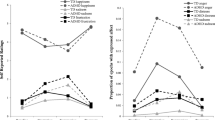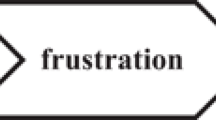Affect regulation (AR) and temperament were examined in children with Autism Spectrum Disorder (ASD). To determine AR, children were exposed to a mildly frustrating situation. Temperament was assessed by the Children’s Behavior Questionnaire (CBQ). Children with ASD showed greater variability in AR and used less effective AR strategies compared to controls. Lower academic ability was associated with less effective AR strategies for the ASD while for the controls older age predicted more effective AR strategies. Those with ASD were lower than controls in Attention Focusing, Inhibitory Control, and Soothability. Of the three overarching temperament factors of the CBQ, only Effortful Control but not Negative Affectivity and Surgency/Extraversion distinguished those with ASD from controls. For the ASD group, higher academic ability predicted higher Negative Affectivity. Fewer symptoms and older chronological age predicted higher Effortful Control.


Similar content being viewed by others
REFERENCES
Alpern G., Boll T., Shearer M., (1984). The Developmental Profile II Aspen, ColoradoPsychological Development Publications
American Psychiatric Association (1994). Diagnostic and statistical manual of mental disorders (4Edition) Washington DC Author
Attwood A. (1998). Asperger’s Syndrome: A guide to parents and professionals. London, UK: Jessica Kingsley
Bailey A., Phillips W., Rutter M., (1996). Autism: Towards an integration of clinical, genetic, and neuropsychological and neurobiological findings Journal of Child Psychology and Psychiatry 37:89–126
Bieberich A. A., Morgan S. B., (1998). Brief report: Affective expression in children with Autism or Down Syndrome Journal of Autism and Developmental Disorders 28:333–338
Blishen B. B., Carroll W. K., Moore, C. (1987). The 1981 socioeconomic index of occupations in Canada Canadian Review of Sociology and Anthropology 24:465–488
Bridges F., Cicchetti D., (1982). Mothers’ ratings of temperament characteristics of Down syndrome infants Developmental Psychology 18:238–244
Butzer B., Kontantareas M. M., (2003). Depression, temperament and their relationship to other characteristics in children with Asperger’s Disorder Journal of Developmental Disabilities 12:67–72
Campos J. J., Campos B. G., Barret K. C., (1989). Emergent themes in the study of emotional development and emotion regulation Developmental Psychology 25:394–402
Derryberry D., Rothbart M. K., (1997). Reactive and effortful processes in the organization of temperament Development and Psychopathology 9:633–652
Eisenberg N., Fabes R. A., Nyman M., Bernzweig J., Pinuelas A., (1994). The relations of emotionality and regulation in children’s anger-related reactions Child Development 65:109–128
Fabes R.A., Eisenberg N., Karbon M., Troyer D., Switzer G. (1994). The relations of children's emotion regularion to their various emotional responses and comforting behaviors Child Development 65: 1678–1693
Fox, N. (Ed.) (1994). The development of emotional regulation: Biological and behavioral considerations. Monographs for the Society for Research in Child Development, 59, 2–3
Frick P. J., (2004). Integrating research on temperament and childhood psychopathology: Its pitfalls and promise Journal of Clinical Child and Adolescent Psychology 33:2–7
Frith U., (2003) Autism: Explaining the enigma 2 Edition. London Blackwell
Goldsmith H. H., Rothbart M. K., (1991). Contemporary instruments for assessing early temperament by questionnaire and in the laboratory In: J. Strelau, A. Angleitner, (Eds), Explorations in Temperament New York Plenum Press (pp. 249–272)
Grolnick W., Bridges L., Connell J., (1996). Emotion regulation in two-year olds: Strategies and emotional expression in four contexts Child Development 67:928–941
Kasari C., Sigman M., (1997). Linking parental perceptions to interactions in young children with autism Journal of Autism and Developmental Disorders 27:39–57
Lord C., Rutter M., DiLavore P., Risi S., (1999). Autism Diagnostic Observation Schedule—WPS Edition Los Angeles, CA Western Psychological Services
Lord C., Rutter M., Le Couteur A., (1994). Autism Diagnostic Interview-revised: A revised version of a diagnostic interview for caregivers of individuals with possible pervasive developmental disorders Journal of Autism and Developmental Disorders 24:659–685
Mangeldorf S., Shapiro J., Marzoff D. D., (1995). Development and temperamental differences in emotion regulation in infancy Child Development 66:1817–1828
Pascualvaca D. M., Fantie B. D., Papageorgiou M., Mirsky A. F., (1998). Attentional capacities in children with Autism: Is there a general deficit in shifting focus? Journal of Autism and Developmental Disorders 28:467–478
Pennington B. F., Ozonoff S., (1996). Executive functions and developmental psychopathology Journal of Psychology and Psychiatry 37:51–87
Posner M. I., Rothbart M. K., (1998). Attention, self-regulation and consciousnessPhilosophical Transactions of the Royal Society of London: Biological Sciences 353:1915–1927
Ratekin C., (1996). Temperament in children with Down syndrome Developmental Disabilities Bulletin 24:18–32
Raver C. C., (1996). Relations between social competency in mother–child interaction and 2-year olds’ social competence Developmental Psychology 32:850–859
Rothbart M. K., (1989). Behavioral approach and inhibition In: J. S. Reznick, (Eds). Perspectives on behavioral inhibition Chicago University of Chicago Press (pp. 130–157)
Rothbart M. K., Ahadi S. A., Hershey K. L., Fisher P., (2001). Investigations of temperament at 3–7 years: The children’s behavior questionnaire Child Development 72:1394–1408
Schopler E., Reichler R. J., Renner B. R., (1986). The Childhood Autism Rating Scale (CARS) Los Angeles Western Psychological Services
Tabachnick, Fidell L. S., (1989). Using multivariate statistics 2 New York Harper/Collins
Thomas A., Chess S., (1977). Temperament and development New York Brunner/Mazel
Tonge B., Brereton A. V., Gray K. M., Einfeld S. L., (1999). Behavioural and emotional disturbance in high-functioning autism and Asperger syndrome Autism 3:117–130
Vaughn B., Contreras J., Seifer R., (1994). Short-term longitudinal study of maternal ratings of temperament in samples of children with Down syndrome and children who are developing normally American Journal of Mental Retardation 98:607–618
ACKNOWLEDGMENTS
This research was supported by a Social Sciences and Humanities Research Council grant to M. Mary Konstantareas. Special thanks to the children and parents who participated in the study. Thanks are also due to Andrea MacKenzie for her contribution.
Author information
Authors and Affiliations
Corresponding author
Rights and permissions
About this article
Cite this article
Konstantareas, M.M., Stewart, K. Affect Regulation and Temperament in Children with Autism Spectrum Disorder. J Autism Dev Disord 36, 143–154 (2006). https://doi.org/10.1007/s10803-005-0051-4
Published:
Issue Date:
DOI: https://doi.org/10.1007/s10803-005-0051-4




